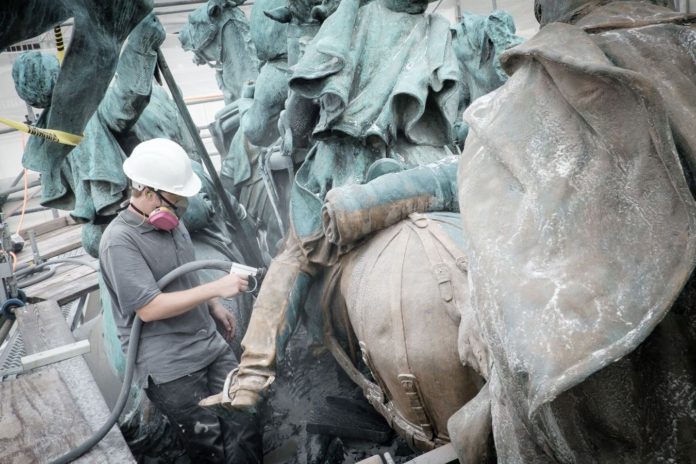WASHINGTON — The bronze face looks etched with worry, the brow creased, the eyes sunken from overwork.
It is not the face of a soldier about to be trampled by charging cavalry horses. But that is how the sculptor, Henry Merwin Shrady, chose to depict himself in a corner of his memorial to Gen. Ulysses S. Grant outside the U.S. Capitol.
Weary. Sick. Beleaguered.
Shrady gave his life to the creation of the Grant Memorial in Union Square, just west of the Capitol. He spent 20 years executing it. In the making, parts of it were twice almost destroyed by fire. And he died two weeks before its dedication in 1922.
Now, 93 years later, the little-known but majestic sculpture — tattered, stained and corroded — is undergoing a months-long restoration by the Architect of the Capitol.
Scaffolding has surrounded the memorial since spring. And experts have been scouring the surface and working to replace some of the 60 swords, scabbards and other items that have been pilfered over time.
The memorial’s eight bronze lampposts vanished long ago, officials said. They will not be replaced.
The memorial, which overlooks the Capitol Reflecting Pool at the opposite end of the Mall from the Lincoln Memorial, is as much a tribute to Shrady as to Grant, wrote Washington historian James M. Goode in his book “The Outdoor Sculpture of Washington, D.C.”
And it is haunted by stories of the great Civil War general and president as well as of the tormented sculptor.
The three-part memorial depicts Grant, the solitary commander, on horseback, swathed in cloak and hat as if on the battlefield. He is flanked on the south by a galloping horse artillery unit and on the north by a charging cavalry group.
The cavalry and artillery elements are dynamic, with plunging horses and riders shouting orders, with a sword raised and flags flying.
“You can sit on a bench and almost be in the action,” said Architect of the Capitol curator Michele Cohen. “It’s so dramatic. I almost think of it as cinematographic. It’s as if you’re sitting in the front row of a movie.
“You can almost hear the roar of the cavalry charging,” she said.
Shrady, who was a native of New York, went to extreme lengths to capture the drama.
He studied and dissected horses to capture their structure precisely. He borrowed the prized stallion of the New York Police Department’s mounted division to study in his studio.
He also borrowed Civil War-era uniforms and equipment from the Army. He modeled the artillery soldiers on three West Point cadets and the cavalry on friends, such as artists Maxfield Parrish and Edward Penfield, according to Goode.
And he used a mirror to sculpt himself as the fallen cavalry rider.
He sketched on notepaper, on letters, on a wedding invitation. He modeled the lead horse in the cavalry group nine times before he got it right, and his thumbprints are captured in the bronze, according to Goode’s book.
Shrady also requested — and was given — 10 deadline extensions, underwent at least one surgery during the project and had several hospital stays related to overwork.
He was under intense pressure from officials in Washington to finish the work that had taken almost 20 years of effort. The original contract was for five years, Cohen said. He was supposed to be finished in 1908.
“Steps must be taken at once to insure the entire completion of this memorial,” Lt. Col. C.O. Sherrill, of the Army’s Corps of Engineers and the Office of Public Buildings and Grounds, wrote him on June 20, 1921.
Sherrill demanded to know when the memorial would be finished and threatened to urge that Shrady’s contract be canceled, according to old letters provided by the Architect of the Capitol.
Shrady died 10 months later at the age of 50.
He had made headlines when he landed the $250,000 commission for the Grant Memorial in 1902 as an inexperienced, 31-year-old sculptor.
But the jury liked his concept for the memorial. And it may not have hurt that his father, George Frederick Shrady Sr., was the one of the lead physicians who treated Grant as he was dying from throat cancer 17 years earlier.
The younger Shrady studied Grant’s death mask and “had some understanding of Grant, the man, based on his father’s observations and interactions,” Cohen said.
Indeed, hidden on the base of the Grant statue is a small, weathered plaque dedicating the statue to the elder Shrady, who had died in 1907.
Grant had been extremely popular after the war and his presidency. His funeral in New York City in 1885 was enormous.
For the young sculptor, the job of memorializing him was overwhelming.
“I was a boy when I won the competition, and never realized the great task before me,” Shrady wrote in 1921, requesting one final extension. “The cost of this work has been so great … (but) I have not neglected to give my best efforts … to make the statue worthy of my country.”
In the end, it did him in.
“It was an enormous struggle,” Cohen said in a recent interview. “Yes, this was a labor of love, but it literally did kill him.”
The elements of the memorial were cast in Brooklyn and arrived piece by piece in Washington over the years — the artillery group in 1912, the cavalry group in 1916 and finally the 10,000-pound-plus Grant statue in 1921, according to news reports at the time.
At the memorial last Thursday, T. Scott Kreilick, whose Oreland, Pa., firm is doing the work, said that his crew is removing corrosion with a micro-abrasive power spray of water and limestone.
Missing or broken elements are being recast, and some will be replaced.
The memorial statues, now light green in color, will be returned close to their original light brown through the application of a new patina and a coating of lacquer and wax, Kreilick said.
And the part of the cavalry sculpture depicting Shrady’s worried face? “I would guess he may have felt that way after this project,” he said.
The memorial, still incomplete, was dedicated before Vice President Calvin Coolidge and a large crowd on April 27, 1922, the 100th anniversary of Grant’s birth.
Shrady had died in a New York hospital on April 12.
At some point later, a small plaque was placed on the artillery group identifying the sculptor and the West Point soldiers who were models.
But Shrady’s middle name was spelled “Marvin,” instead of Merwin.
It has never been corrected.








